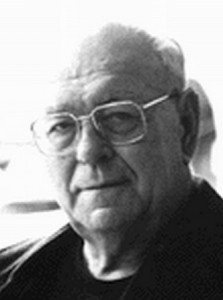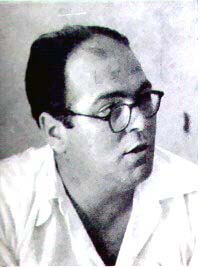by Joseph Geraci
In March, 1969, Danilo Dolci was in New York for the publication of his book, The Man Who Plays Alone. Dorothy Day and I had the good fortune of meeting him for an hour and a half, in a quiet corner of the lobby of the famous Algonquin Hotel, along with ten or so others that included Dolci’s biographer, Jerre Mangione, his editor, the journalist and co-founder of Pax, Eileen Egan and various press people.

Danilo Dolci; c. 1970; public domain image; photographer unknown.
Dolci was actually born in Sezana, Yugoslavia, under Italian administration at the time of his birth. So, if you were to imagine a small Sicilian type, you would be surprised. He is over six feet tall and solidly built; his eyes dark blue, behind gold-rimmed glasses. He was wearing an inexpensive knit suit and tie, and spoke without gestures. His answers to our questions were short and precise, often only a yes or no; he always looked directly at the questioner, sometimes returned a question with a question, and sometimes made a joke. Dolci has also published a volume of poetry; he uses words carefully and precisely.
Read the rest of this article »
by Joseph Geraci
A Passion for Sicilians: The World Around Danilo Dolci by Jerre Mangione. New York: William Morrow, 1968.
Danilo Dolci has been dubbed the “Gandhi of Sicily.” Since the mid 1950s he has attracted attention as one of the world’s leading social reformers and nonviolent activists. His methods and thought should have attracted considerable attention in America, where the need for both grassroots planning (pianificazione) and local redevelopment is apparent, although he remains relatively unknown.

Danilo Dolci, c. 1955; photographer unknown; courtesy of wikimedia.org
Who is Dolci? This is the question Mangione’s comprehensive book sets out to answer. Thanks to a Fulbright grant, Mangione was able to spend several months of 1965 in Partinico, living near Dolci, and his Center of Studies. Part journal, part travel diary, part biography, it holds surprises. For example, Dolci is not Sicilian, and is barely Italian. “His Italian father had German and Italian parents; his Slav mother had parents who were German and Slav. This makes him half German, one quarter Slav and one quarter Italian.” Indeed, the town of Sezana, where he was born on June 29, 1924, is part of Yugoslavia; at the time “administered” by Italy. He began his intellectual life reading not the literature of rebellion and revolution but the classics, including the Koran, the Bhagavad Gita, Confucius and the Tao te Ching. He never read Thoreau and read Gandhi only after a French journalist referred to him as the “Gandhi of Sicily.” His first published book was a book of poetry. He studied architecture for four years in Milan but did not take a degree, stopping short a few weeks before graduation.
Read the rest of this article »
by Joseph Geraci

Original poster; artist unknown; courtesy of gandhijis-talisman.posterous.com
An extraordinary meeting took place October 7 [1969] in New York City, between Danilo Dolci and Cesar Chavez. That two of the most prominent leaders of the nonviolent land reform and resistance movement should meet might afford a glimpse of not only where the movement was, but in what direction it might conceivably go.
The meeting was attended by only a handful of people: Mrs. Coley, who was handling the arrangements for Dolci’s visit; Mark Silverman, head of the grape boycott in New York State; Anne Israel, a supporter of the boycott in whose apartment Chavez was staying; Dorothy Day; the photographer Bob Fitch, and myself. It was to begin at 6:30 P. M., but as Dolci was coming to the meeting directly from the airport, there was the inevitable delay. Chavez had arrived earlier with several co-workers, New York being the latest stop on their national tour. He walks with a slight limp, the result of a bone disease contracted after a fast. As we waited for Dolci, he told us that the recent grape boycott rally in Washington had been very successful. Spirits were high and there was a real determination to work hard and continue. In talking to some of the other boycotters there that evening one had the same impression. Mr. Ortiz, an organizer from Sacramento who will be helping Mark Silverman in New York, said that progress was slow but that everyone was very hopeful.
Read the rest of this article »
by Geoffrey Ostergaard
“Nonviolent revolution” is a relatively novel and, at first glance, paradoxical concept. In classifying principled nonviolence, Gene Sharp describes it as “the most recent type”, dating from about 1945, and as “still very much a direction of developing thought and action rather than a fixed ideology and program.” (1) As the term itself suggests, it is an ideological hybrid, the product of two hitherto distinct, though not unrelated traditions of thought. The first of these traditions is “pacifism”, the defining feature of which is the rejection, on principle and as a guiding rule of individual conduct, of violence, especially but not only the institutionalised violence manifested in war. The “peace testimony” of the Quakers made in 1661 typifies the pacifist stance: “All bloody principles and practices we (as to our own particular) do utterly deny, with all outward wars and strife and fighting with outward weapons, for any end or under any pretext whatsoever . . .” (2)
Read the rest of this article »
by Geoffrey Ostergaard
“In the ideal state every one is his own ruler. He rules himself in such a manner that he is never a hindrance to his neighbour. In such a state, therefore, there is no political power because there is no State.” M. Gandhi (Young India, 2 July 1931)
The practical difference between socialism and anarchism, at the purely local level, is small. They differ, of course, in how each responds to the question of a state and national policy. Gandhi saw an India with a plethora of local problems, and for them he prescribed local solutions. In this respect, his thinking and philosophy most closely resemble Western anarchism than any other political philosophy. In fact, he acknowledges Tolstoy, especially his spiritual anarchist treatise The Kingdom of God Is Within You, as an influence. But Gandhi’s political thought is not derivative, it originally combines his Hinduism and his thoughts on non-violence. Nevertheless, many concepts familiar to the student of Western anarchism are also present in the philosophy of Sarvodaya.
Read the rest of this article »







